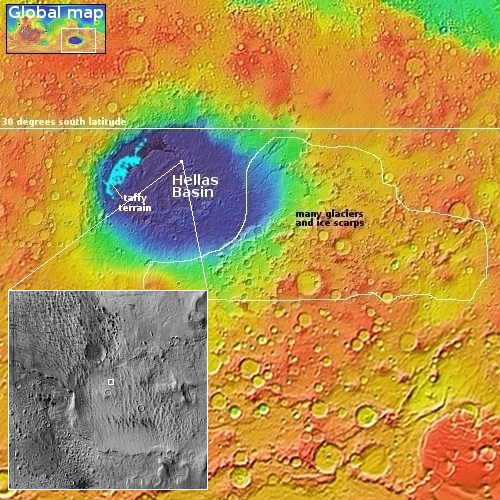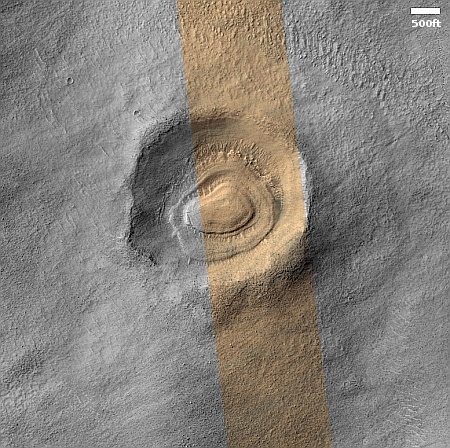Glacial material even in Mars’ Death Valley
Cool image time! The picture to the right, cropped, reduced, and sharpened to post here, was taken on October 25, 2024 by the high resolution camera on Mars Reconnaissance Orbiter (MRO).
The science team labels this a “layered feature,” which is appropriately vague in order to not prematurely push a conclusion that is not yet proven. Extensive orbital imagery and data however strongly suggests the layers inside this crater are glacial in nature, each layer laid down during Mars’ many thousands of climate cycles as the planet’s rotational tilt swung back and forth from 11 degrees to 60 degrees. According to the most popular theory today, when that tilt was high, the mid-latitudes (where this 3,000-foot-wide unnamed crater is located) were actually colder than the planet’s poles. The water ice at the icecaps would then migrate from the poles to the mid-latitudes, causing the glaciers to grow.
When the tilt was low the process would reverse, with the mid-latitudes now warmer than the poles, causing the glaciers to shrink. The wedding cake nature of these layers is likely because, over time, Mars has steadily lost its total budget of water to space, so with each cycle the glacier could not grow as much.
Though many such glacial-filled craters have been found in the mid-latitudes, reinforcing these theories, the location of this crater is even more interesting.

The white dot on the overview map to the right marks the location, deep within Hellas Basin, which I sometimes refer as the Death Valley of Mars because it has the red planet’s lowest elevation. As you can see from the map, researchers have found many glacial features to the east and south of Hellas, but apparently not so many within the basin. This crater however tells us that lack might be partly the result of observation biases and not an actual lack. Because of Hellas’ depth, the atmosphere there is often obscured by dust and haze, making many detailed observations more difficult.
At the same time, the terrain within Hellas is also strange (note the region labeled “taffy terrain“), suggesting the lack is also partly due to different processes — thought to be related to near-surface ice — that twist and warp that surface and therefore wipe clean past geological evidence, such as craters.
This crater however once again suggests that easily accessible water is plentiful on Mars. The red planet is not a dry desert like the Sahara, but instead more like Antarctica, a desert covered with ice.
On Christmas Eve 1968 three Americans became the first humans to visit another world. What they did to celebrate was unexpected and profound, and will be remembered throughout all human history. Genesis: the Story of Apollo 8, Robert Zimmerman's classic history of humanity's first journey to another world, tells that story, and it is now available as both an ebook and an audiobook, both with a foreword by Valerie Anders and a new introduction by Robert Zimmerman.
The print edition can be purchased at Amazon or from any other book seller. If you want an autographed copy the price is $60 for the hardback and $45 for the paperback, plus $8 shipping for each. Go here for purchasing details. The ebook is available everywhere for $5.99 (before discount) at amazon, or direct from my ebook publisher, ebookit. If you buy it from ebookit you don't support the big tech companies and the author gets a bigger cut much sooner.
The audiobook is also available at all these vendors, and is also free with a 30-day trial membership to Audible.
"Not simply about one mission, [Genesis] is also the history of America's quest for the moon... Zimmerman has done a masterful job of tying disparate events together into a solid account of one of America's greatest human triumphs."--San Antonio Express-News
Cool image time! The picture to the right, cropped, reduced, and sharpened to post here, was taken on October 25, 2024 by the high resolution camera on Mars Reconnaissance Orbiter (MRO).
The science team labels this a “layered feature,” which is appropriately vague in order to not prematurely push a conclusion that is not yet proven. Extensive orbital imagery and data however strongly suggests the layers inside this crater are glacial in nature, each layer laid down during Mars’ many thousands of climate cycles as the planet’s rotational tilt swung back and forth from 11 degrees to 60 degrees. According to the most popular theory today, when that tilt was high, the mid-latitudes (where this 3,000-foot-wide unnamed crater is located) were actually colder than the planet’s poles. The water ice at the icecaps would then migrate from the poles to the mid-latitudes, causing the glaciers to grow.
When the tilt was low the process would reverse, with the mid-latitudes now warmer than the poles, causing the glaciers to shrink. The wedding cake nature of these layers is likely because, over time, Mars has steadily lost its total budget of water to space, so with each cycle the glacier could not grow as much.
Though many such glacial-filled craters have been found in the mid-latitudes, reinforcing these theories, the location of this crater is even more interesting.

The white dot on the overview map to the right marks the location, deep within Hellas Basin, which I sometimes refer as the Death Valley of Mars because it has the red planet’s lowest elevation. As you can see from the map, researchers have found many glacial features to the east and south of Hellas, but apparently not so many within the basin. This crater however tells us that lack might be partly the result of observation biases and not an actual lack. Because of Hellas’ depth, the atmosphere there is often obscured by dust and haze, making many detailed observations more difficult.
At the same time, the terrain within Hellas is also strange (note the region labeled “taffy terrain“), suggesting the lack is also partly due to different processes — thought to be related to near-surface ice — that twist and warp that surface and therefore wipe clean past geological evidence, such as craters.
This crater however once again suggests that easily accessible water is plentiful on Mars. The red planet is not a dry desert like the Sahara, but instead more like Antarctica, a desert covered with ice.
On Christmas Eve 1968 three Americans became the first humans to visit another world. What they did to celebrate was unexpected and profound, and will be remembered throughout all human history. Genesis: the Story of Apollo 8, Robert Zimmerman's classic history of humanity's first journey to another world, tells that story, and it is now available as both an ebook and an audiobook, both with a foreword by Valerie Anders and a new introduction by Robert Zimmerman.
The print edition can be purchased at Amazon or from any other book seller. If you want an autographed copy the price is $60 for the hardback and $45 for the paperback, plus $8 shipping for each. Go here for purchasing details. The ebook is available everywhere for $5.99 (before discount) at amazon, or direct from my ebook publisher, ebookit. If you buy it from ebookit you don't support the big tech companies and the author gets a bigger cut much sooner.
The audiobook is also available at all these vendors, and is also free with a 30-day trial membership to Audible.
"Not simply about one mission, [Genesis] is also the history of America's quest for the moon... Zimmerman has done a masterful job of tying disparate events together into a solid account of one of America's greatest human triumphs."--San Antonio Express-News


